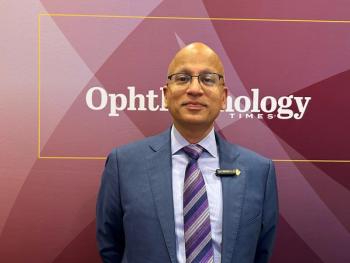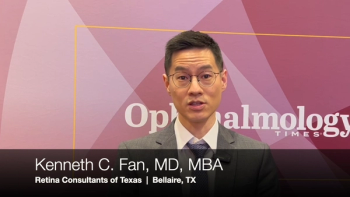
Drug-delivery technologies will transform care
By Fred Gebhart
First-line treatment for glaucoma has changed little since the early 20th Century. Clinicians have more drug options today, but topical medications intended to reduce IOP remain the primary treatment modality. Sustained-release drug delivery devices offer promise to transform glaucoma care.
Multiple studies have found that fewer than half of glaucoma patients are adherent to eye drops by the end of the first year of treatment. Only half of those can self-administer eye drops correctly on a regular basis. It is not that patients don’t want to adhere to treatment regimes; they simply can’t because of age and comorbidities.
“At the end of the day, we will have a way, or ways, to take the patient out of the equation and allow the drug to exert its maximum effectiveness,” predicted Robert Fechtner, MD, director of Glaucoma Division at Rutgers New Jersey Medical School, Newark. “Sustained release or controlled release is a very important component for driving effective drug delivery.”
Dr. Fechtner co-moderated “New Horizons in Drug Delivery” with Eliot Lazar, MD, president of elCon Medical. Eight companies presented four drug delivery technologies: solid implants, punctal plugs, injectable gels, and implantable pumps. Several devices are in phase II trials and some are moving toward phase III.
Listen as each of the eight compnaies present their drug-delivery technologies at the New Horizons Forum.
DSM Biomedical
DSM Biomedical uses injectable amino acid-based polyesteramide (PEA) fibers containing latanoprost for glaucoma. PEA can be fabricated into fibers, rods, films, micro- and nano-particles and coatings, said Miriam Gillissen, program manager for drug delivery.
A single fiber injected into the conjunctiva delivers a steady dose of latanoprost. The drug-eluting fiber showed a 6 mm Hg reduction in IOP over 6 months, she said. The IOP reduction is similar to eye drops with fewer adverse events compared to topical drops and full adherence.
“The ophthalmologist can take direct control of treatment and address the poor adherence that is typical with eye drops,” Gillissen said. “The patient is relieved of the need for daily drug and the reduction in quality of life due to glaucoma advancing when they are not adherent. For the pharma industry, the drug-laden fiber offers a new delivery product in a competitive market.”
Envisia Therapeutics
Envisia Therapeutics borrowed from microelectronics to print micro- and nano-sized polymers that can be filled with active ingredient and injected or inserted into the appropriate ocular site. The company is in phase IIa on a 6-month biodegradable rod-shaped formulation of travoprost for glaucoma, said Chief Scientific Officer Benjamin Yerxa, PhD. Future plans include an IND for biodegradable steroid formulations for post cataract inflammation and extended release formulations of biologic agents.
In a beagle model, an intracameral travoprost implant showed a 32% reduction in IOP from baseline over 8 months from a single dose. Yerxa said he hoped to have human data to report in 2016.
“The drug is available 24/7 at the optimal concentration,” Yerxa said. “The rod is fully biodegradable and nothing is left in the eye at 6 months. This puts treatment in the hands of the clinician, not the patient.”
ForSight VISION5
ForSight VISION5 is developing Helios, a flexible prostaglandin-eluting ring that fits beneath the eyelids. The target drug delivery and replacement cycle is 6 months, said CEO John Maroney, matching the typical medical visit schedule for glaucoma.
Phase I data shows a 6.7 mm Hg reduction in IOP over 3 months. The most frequent adverse events were hyperemia, similar to or less than levels reported with prostaglandin drops, and slightly elevated mucus. Phase II showed sustained IOP lowering over 6 months. The company is planning a phase III trial for 2016.
“Prostaglandin works, but only if you take the drops, which most patients don’t,” Maroney said. “Helios is convenient for patients. It’s easy. It ensures continuous dosing. It gives physicians control over dosing and payer can recognize financial benefits from better control disease.”
Each panelist in the New Horizons in Drug Delivery session presented technologies that feature a sustained- or controlled-release component.
GrayBug
GrayBug is developing micro- and nanoparticle-controlled release vehicles for injection. The particles are at the injection site and remain outside the visual axis, said Justin Hanes, PhD, founder and chief scientific officer. Drug is released as the particles erode at a controlled rate and are absorbed. The company is working with glaucoma drugs for both neuroprotection and IOP-lowering.
The neuroprotective agent targets DLKinase, a key initiator of neuron death in glaucoma. In a rat model, the most effective dose protected about 90% of neurons from artificially elevated IOP. Optic nerve transection studies show the agent protects against retinal ganglion cell (RGC) degeneration. A prostaglandin IOP-lowering study showed a 3 mm Hg drop in IOP in normotensive rabbits.
“Our particles form a mass, which allows for more drug to be implanted,” Hanes said. “We can package small molecules and macromolecules and they all stay where they are injected.”
Mati Therapeutics
Mati Therapeutics is nearing its first phase III trial of The Evolute, a punctal plug that elutes latanoprost. The device has been tested in nearly 700 patients across 10 clinical trials with more than 6 months of treatment exposure in some patients, said Bob Butchofsky, founder and CEO.
Punctal plug delivery gives less overall drug exposure compared to drops with more drug actually delivered, he said. The latest phase II U.S. trial showed a consistent 5 mm Hg to 6 mm Hg reduction in IOP over 3 months, at which point the plug is replaced. Trials show the standard latanoprost adverse events, but conjunctival hyperemia is only 7.6%, about half the rate seen with eye drops.
“We see room for multiple technologies to replace eye drops,” Butchofsky said. “It will be good for the physician community and for the patient community to have multiple choices to replace eye drops.”
Ocular Therapeutix
Ocular Therapeutix loads its punctal plug with prostaglandin. The plug is dry when inserted, then softens and expands upon contact with tears. The plug is in phase IIb trials while the same system, loaded with steroid for post-op pain and inflammation, is in phase III, said Art Discoll, vice president of product development.
Phase IIa results show robust, clinically significant IOP reduction at 3 months. Plugs are well tolerated by patients with no change in hyperemia, no excessive tearing, and no serious adverse events.
“Our view is to transform the treatment of ocular disease using sustained release to reduce the need for frequent drops or injections,” Discoll said. “We are enrolling a phase IIb trial in the United States and planning phase III activity.”
Euclid Systems
Euclid Systems is developing collagen-based vehicles. Viscous formulations are injected through a 30-gauge cannula or needle and form homogenous beads within one minute. Films and wafers can be designed to degrade from a few hours to 6 months and longer and implanted.
Collagen is already used in FDA-approved or cleared ophthalmic devices, said Chief Scientific Officer Dale DeVore, PhD. It can be manipulated into different physical forms with controlled bioresporption characteristics. In vitro studies using gel formulation and rabbit studies in rabbits show steady state delivery of latanoprost for 180 days.
“Our vehicle can be made in almost any physical configuration–gels, wafers, rods, fibers–to fit the target tissue and delivery method,” DeVore said. “It can be loaded with almost any drug and shows stead state distribution with both hydrophilic and hydrophobic agents.”
Replenish
Replenish is developing the world’s smallest, refillable, implantable pump. The pump is inserted into the vitreous, where it both measures IOP hourly and delivers daily drug doses of 200 nL to 10 uL. The physician reads IOP data remotely and changes drug dosing as appropriate.
The pump is invisible from the outside and holds 6 months of drug. The reservoir is cleaned and refilled in the clinic using a proprietary 31-gauge needle system. A rabbit model shows a single infusion directly next to the ciliary body causes sustained IOP lowering.
“We have the opportunity to combine continuous IOP-monitoring with therapeutic delivery of medication,” said Sean Caffey, MD, co-founder and chairman. “The physician can change the dose remotely as needed. It can even be set to intervene while the patient is sleeping. Marrying the therapeutic with the diagnostic is the solution for glaucoma.”
Newsletter
Don’t miss out—get Ophthalmology Times updates on the latest clinical advancements and expert interviews, straight to your inbox.



















































.png)


